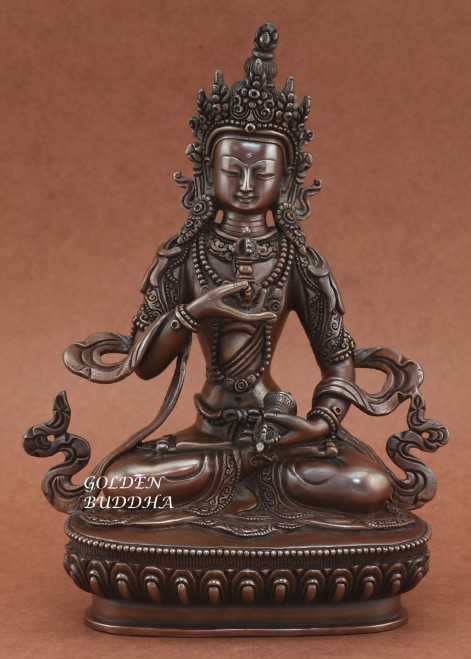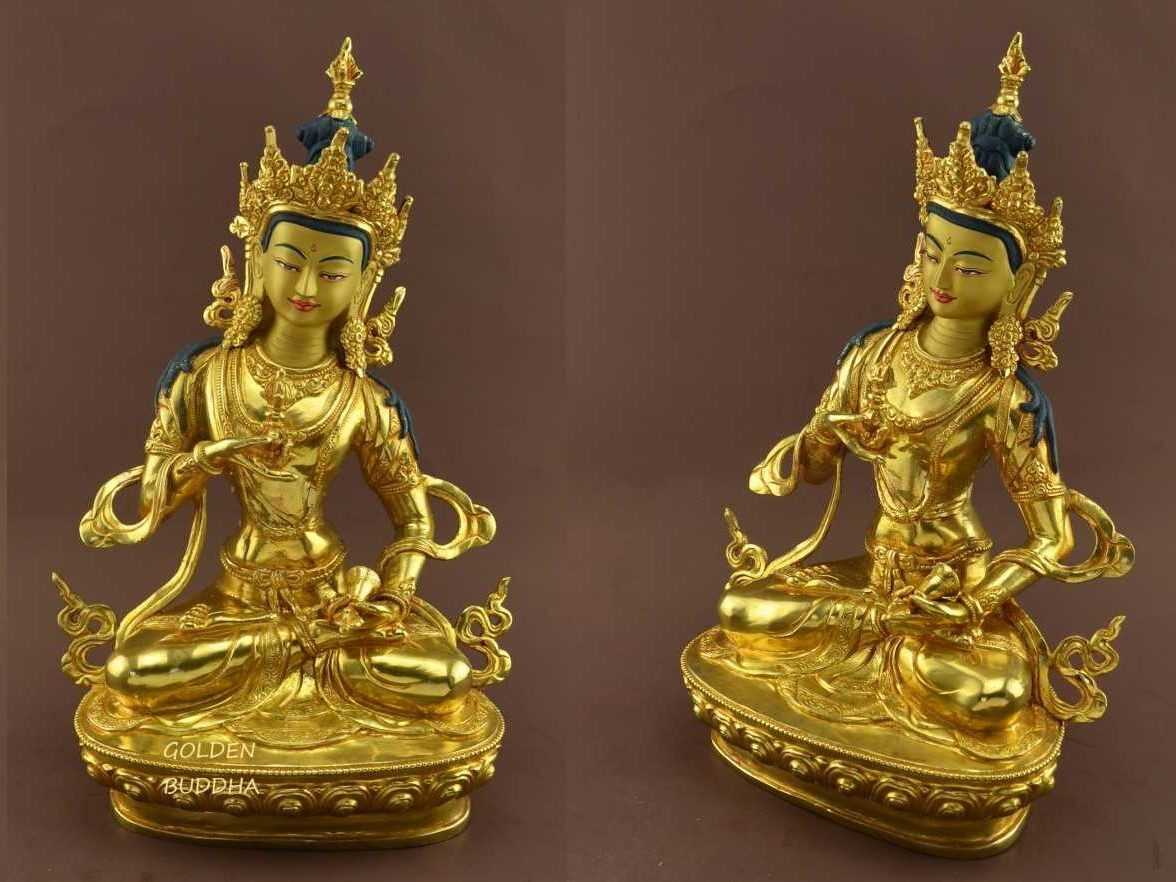Vajrasattva statues represent an integral and complex Buddhist deity in both Mahayana and Vajrayana Buddhism. This is because Vajrasattva is the sambhogakaya embodiment of Vajradhara, the primordial Buddha. Vajradhara is the Dharmakaya, which is the absolute truth or primordial wisdom.
What is primordial wisdom? Primordial wisdom is like gravity which has always existed as the base component of the universe. Indeed, it is very similar to gravity because the universe would fall apart without it. Unfortunately, wisdom has not been given a scientific definition. Nonetheless, it is the glue that holds everything together.
Perhaps it is difficult to envision primordial wisdom. Therefore, a Vajrasattva statue can be a very useful tool. As a result, sentient beings can envision the primary components of enlightenment.
Symbols of Enlightenment

Vajrasattva Statues and “Sambhogakaya”
Mahayana Buddhists believe there are three bodies (kayas) the Buddhas use to present themselves. In Sanskrit, the word “Trikaya” literally translates as “three bodies”. These three bodies are:
- Dharmakaya – This is known as the “truth” body. It is the embodiment of enlightenment and knows no limits or boundaries.
- Sambhogakaya – is a “clear light manifestation” or a “subtle body of limitless form”.
- Nirmanakaya – This is the physical human body of the Buddha as he would appear as a regular person. For example, Shakyamuni Buddha used nirmanakaya when he existed in the human realm.
The sambhogakaya is the most versatile embodiment. However, this embodiment is not limited to the Buddhas and can also be used by high level Bodhisattvas.
Sambhogakaya Purpose and Appearance
The Vajrasattva image is the sambhogakaya embodiment used by Vajradhara Buddha. Therefore, the true nature of Vajrasattva might be difficult to conceptualize at first because of this esoteric description. If you could visualize a “body of bliss” or a “subtle body of limitless form” then you could see the real image of Vajrasattva. Perhaps this may look like a rainbow to an unenlightened sentient being?
Buddhas and high level Bodhisattvas take this form in their own pure lands to teach Bodhisattvas by using visionary experiences. Indeed, they can take any form necessary to reach their target audience.
The Buddha or Bodhisattva who has taken the form of Sambhogakaya has transformed into a concept. Therefore, they no longer have a physical body unless there is a need to take human form.
Vajrasattva Statue Meaning
Perhaps understanding the Vajrasattva meaning can assist with visualization? In Sanskrit, Vajra means both “diamond” or “thunderbolt”. Additionally, sattva is an element of energy that is pure, wholesome and virtuous. Indeed, the Vajrasattva statue meaning seems to translate as diamond of indestructible virtue or character of unshakable virtue.
In the Pali Canon the Buddha taught his disciples that whoever sees the Dharma, sees him. Therefore, using the human body to represent Buddhist values has become redundant for advanced practitioners.
Gautama Buddha – “Whoever sees the Dharma sees Me.”
As a result, a Buddha or high level Bodhisattva may not always use human form to personify a virtue. This is because advanced practitioners do not need to see a human body to receive the teachings.
However, a Buddha or Bodhisattva who appears in this manner is using a manifestation that their audience will best understand. Therefore, if a Buddha is trying to communicate with a small child, then they appear as a small child. But if they are teaching Bodhisattvas in their pure land, they can effectively appear as “bliss” or “clear light”.
Antiquated Vajrasattva Statue

Vajrasattva Mantra for Karma Purification
In Tibetan Buddhism, Vajrasattva mantra recitations are used to purify karma, induce tranquility and also virtue. There is a 100 syllable mantra and a 6 syllable mantra. Indeed, the Vajrasattva short mantra is simple and easy to remember. All you need to say is “Om Vajrasattva Hum”.
“Om Vajrasattva Hum”
Since the shorter mantra includes the essential spiritual elements it is considered equally beneficial. At least that is what some lamas teach their followers. However, the longer mantra clearly takes much more effort and dedication.
Vajrasattva Rituals
Vajrasattva statues are the centerpiece of Vajrasattva rituals. Devotees concentrate on purification of the 5 aggregates during the ritual. This is because sentient beings perceive all physical and material form through the 5 aggregates. As a result, purification of the aggregates is believed to purify past unwholesome karma. Eventually, the elimination of the aggregates can result in emptiness or the “State of Vajradhara”, commonly known as Nirvana.
As a Bodhisattva on the path to enlightenment, Vajrasattva declared his intense desire to assist sentient beings. However, the main objective was to assist those who had committed serious crimes or those who had broken their samaya vows.
Indeed, Vajrasattva vowed to benefit those who recite his mantra, hear his name or think of him. If so, their karma will be purified. Furthermore, he declared that he would not accept enlightenment until he could effectively purify all unwholesome karma.
Beautiful Vajrasattva Statue

Is a Vajrasattva Statue also Vajrapani?
Vajrapani is sometimes called Vajrasattva in Mahayana Buddhism and often appears as a wrathful deity. Although a Vajrasattva statue is a peaceful Sambhogakaya manifestation, he theoretically can take any form including wrathful manifestations of Vajrapani (Vajrapani can appear as peaceful, semi-wrathful or wrathful).
However, Vajrapani is the embodiment of the Buddha’s power and he acts as the guide and protector of the Buddha. Therefore, he is a completely different deity. Additionally, Vajrapani is often depicted alongside Avalokiteshvara (Buddha’s compassion) and Manjushri (Buddha’s wisdom). Vajrapani is therefore unique and has his own identity which is exclusive of Vajrasattva.
However, as a Sambhogakaya “subtle body of limitless form” Vajradhara has the power to take any kind of embodiment, including wrathful Vajrapani. Furthermore, the Buddhist texts state that accomplished Bodhisattvas such as Avalokiteshvara can take any form necessary to relieve the suffering of sentient beings. Certainly, Buddhas would also have these transformative abilities.
The Bodhisattva Vajrasattva, simply gives form or conception to the versatile mechanism of Sambhogakaya.

